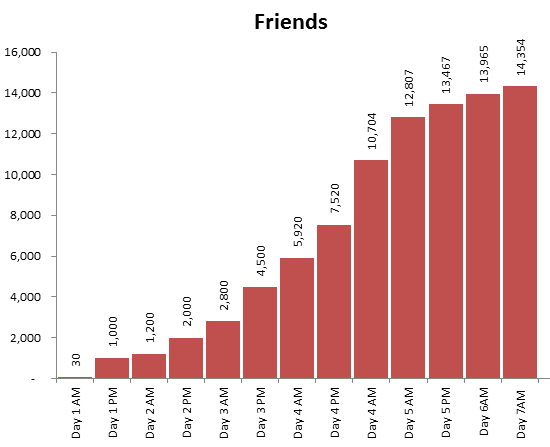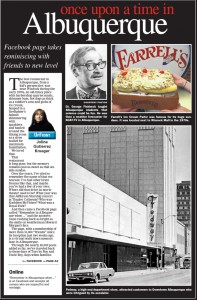Come listen to the latest trends in recruiting millennials with housing to our market.
Guest Speakers: Todd Clarke CCIM and Dale Dekker
http://www.techfiestaabq.com/
Confessions of a Commercial Real Estate Consultant
View Cantera Consultants & Advisors Inc. recent consulting assignments
Come listen to the latest trends in recruiting millennials with housing to our market.
Guest Speakers: Todd Clarke CCIM and Dale Dekker
http://www.techfiestaabq.com/
The following are links and documents from todays presentation.
Complete the 2014 ULI Value / CAP rate survey here
Prezi from today – Ethical use of social networking Prezi-CCA-EthicalUseofSocialMedia-072014
List of iOS apps – click here
Today’s powerpoint presentation can be found by clicking here- SantaFe-Tech-SocialNetworkingWebinar-07182014-v5
CCIM 2013 annual seminar – 97 apps in 90 minutes
Click here for the technology blog
At the annual Apartment Association market update last week, Todd Clarke discussed the latest generational drivers of apartment demand. View the complete article by clicking here.
This month’s CCIM magazine has an update article on the multifamily industry.
“In some markets, demand is up and the existing multifamily properties are simply obsolete. “We need to replace our inventory,” says Todd D. Clarke, CCIM, chief operating officer of NM Apartment Advisors in Albuquerque, N.M. “The average apartment was built in 1965, is red brick, pitched roof, master metered, and built furnished — none of which is what the baby boomers and Generation Y are looking for.” Developers are expected to deliver 560 units in Albuquerque this year — up from 158 in 2012, according to Marcus & Millichap.
Generation Y, in particular, is expected to be key to multifamily leasing and development. A significant portion of this 87.3 million-strong population segment will form new households as they leave their parents’ homes during the next two years, Marcus & Millichap notes.”
Global Capital Markets> JLL Global Markets
Jones Lang Lassale – https://www.joneslanglasalle.com/Pages/Research.aspx
AND
most of them will be left behind by the top 50 cities in china

Surpassing a previous record of building a 15 story hotel building in 6 days, the Chinese company, the Broad Group has constructed a 30 story building in only 15 days.
It would appear a majority of the building was built off site in panels that were lifted into place, a practice that is likely to become much more common in the near future. A 6 minute time lapsed video can be viewed here.
Thanks to Gizmodo.com for the original article.
A quick update to this posting (12/19/2011): This article about China’s property bust reminds me of a saying I learned during my travels in China “In my first month, everything in know about China would fill an encyclopedia. In my first year, everything I know about China would fill a book. In my first decade, everything I know about China would fill one page.”

I thought this email chain was a perfect example of being able to take CCIM 102 market analysis knowledge and apply it to global dynamics.
Fellow CCIM instructor Carl Russel wrote me the following email about a video on China he recently saw:
Haven’t we been teaching CCIM 102 in China for a number of years? Maybe they’re not as smart as we thought. If they have so much money, why don’t they invest in the United States….oh, they already are….never mind…Is this a 102 Case Study, or should it have been? Unbelievable video non youtube.
Carl G. Russell, CCIM, SIOR
Executive Vice President
George J. Smith & Son Realtors
and my response is below:
Carl-
Thanks for sharing – very interesting story – I am adding it to my ongoing list of resource on China Demographics for an article that I have been working on for quite a while now.
The whole idea of this much housing being empty is amazing.
If you have read Greg Lindsay (Skip @ CCIM’s son) book, Aerotropolis, he mentions that there are between 125 to 150 cities in China with a population over a million people compare that with 8 to 20 (depending on if you count “cities” or “MSA’s”) in the United States. Noted author, Greg Lindsay has dubbed many of these “instant cities“.
Many of these cities were created in the last 30 years as China has pulled over 350 million people out of rural poverty into urban jobs.
Since they don’t share their census info, and measuring is often erratic at best, many scholars have spent time trying to do simple things like determine trade areas in China like this report.
Today, there are more “urban” Chinese than there are American’s (total). There are more Chinese that speak English, than there are American’s (total). There are almost as many single men in China who have no hope of finding a wife (due to the gender imbalance from the one child policy which averages 119 boys for every 100 girls) as there are men in America.
I would disagree with the story about the lack of demand for these housing units, since a majority (just under a billion people) of China’s population is still considered rural, and unlike here, needs government approval to move into the large cities. As China continues its precarious balance between keeping the urban population happy with low food prices and the rural population with high food prices (this tight rope act has not prevented tens of thousands of “protests’ this year alone), it will be improving its agricultural efficiency, moving hundreds millions into the cities to pursue industrial (or information) employment, which will provide the income to pay for the housing.
Assuming 3 people per household, 64,000,000 empty apartments would support 192,000,000 people, or about 20% of the current rural population. Looking at it that way, I feel there is a similarity between these empty cities and America’s company towns of a hundred years ago – manufactures like Ford, Cannon, and many others created towns and filled them with their employees.
That said, I know many of us who have visited China on and off over the years have been amazed and appalled at the brutal efficiency central planning.
Lest anyone get their hackles up and try to turn this a political conversation, know that like them or not, the sheer scale of what they have achieved in 30 years is unprecedented in this planet’s history, and as much as we may bemoan lost manufacturing jobs to China, those jobs have pulled hundreds of millions out of severe poverty and their pay scale is rocketing upwards to the point where it is possible that the average Chinese person’s salary could match western European levels.
Finally, I liked the end of the video – watching the agents sell the reporter – it reminded me of GlenGarry / Glen Ross (the ABC’s – always be closing).
Thanks again for sharing!
Todd
Additional resources:
Urban vs. Rural
PRC demographics – http://en.wikipedia.org/wiki/Demographics_of_the_People’s_Republic_of_China
China demographics by sex
USA cities by population
USA housing breakdown –
http://ilookchina.net/2011/03/13/western-minds-may-have-it-wrong-about-china-building-empty-cities/
We have been following Albuquerque’s homeless story for quite a while.
This video update was recently featured at the City of Albuquerque’s state of the city speech.
Robert Nelson at Metropolitan Homelessness Projected shared this update with us:
“Greetings!
I just wanted to write and share a new video that the city produced for the Mayor’s State of the City Address this past Wednesday. We’ll be reaching some milestones very soon and I wanted you to know about them. To date, 43 people have been housed in permanent housing and we’ll probably reach 50 in the next week. We’ll keep pressing onward to house 75 people by February 2012. With this rapid increase of housing, I want to also thank you for your help volunteering for us over the past few months. Because of you, we have been able to get this initiative going from the ground up – from Survey Week back in February to delivering furniture and housewares to those who were newly housed to the ongoing conversation on how we sustain housing for our clients. Thank you.
The link below is a video not only of the initiative and where we’re headed, but it also includes some of the stories of the people that have lived on the streets for years and finally moved into housing. Please share this video with your family, friends and colleagues and help us spread the word about our mission to end homelessness. Hope this message finds you well and thank you again for your support.
Robert Nelson | Metropolitan Homelessness Project”
OR, using Groups effectively on Facebook.
As someone who has covered, spoken and taught courses on social networking, I can tell you this the fastest evolving part of the internet today. Facebook membership is rumored to be over 750 million people, or 20% of all of the business people on the internet today.
During the last few years I have seen mildly ineffective to downright disastrous uses of social networking, and the successful uses are fewer and far between.
Today I would like to focus on one of that success by focusing on a local Facebook group page that grew its membership from 30 to 15,000 and experienced over 40,000 posts in one weeks time.

The group Remember when in Albuquerque… had a simple concept – encourage local Albuquerque’s to share their memories of by gone places, people, and events.

The original idea came from Laura Reynolds, a Realtor in Las Cruces, who came across a Facebook group that allowed people who grew up in Ft. Worth to share memories. Laura suggested to her husband that he start a group about Albuquerque.
Steve started the group, Remember when in Albuquerque and quickly had 30 members. As those members started to tell their friends, and started posting their Albuquerque, memories, growth started to accumulate exponentially, and Steve requested a handful of us help administer (myself included).
I kept track twice a day of the growth of the group:

While the occasional commercial does popup on the group and there has been some sniping about deleted posts, the group has continued to grow as more people share their memories about Albuquerque.
Although many people know that four generations of my family has lived and worked in Albuquerque, many don’t know that I am an Albuquerque history buff and have a large collection of old photos, postcards and books. What better venue to share these? As I shared, others chimed in, and my “friends” counter increased by another 15% or so. (No, I don’t know all of them, but if they love Albuquerque history as much as I do, why would I tell them no?)
The group has received recent coverage from the local to TV new on KRQE as
As well as a front page article in the Albuquerque Journal:

Is this a short term fad, or a long term trend?
For now, I would say long term trend. Although Facebook doesn’t share average time spent on any one group, a common expression from group members is how much fun they’ve had strolling down memory lane, and how much of their day has flown by.
Even after growth in the group stabilized at 15,000 (or so members), the media coverage has exposed the group to new people who are asking to join, creating that ever increasing spiral of increasing exposure, which is truly any marketers dream.
All in all, I’d label this a “sticky” success.

Aerotropolis, the way we’ll live next
Authors: Greg Lindsay & John D. Kasarda,
Publishing Info: Farrar, Straus and Giroux, Nonfiction, First edition published March 1st, 2011
As an international instructor for the CCIM institute I discovered that the book, Aerotropolis: the way we’ll live next dovetails nicely with what the just-in-time delivery model as a primary driver of demand for industrial space that we teach in the CCIM 102 course, I would highly recommend it to anyone in commercial real estate.
As a rabid book consumer, I will easily digest about 100+ books a year, and without a doubt, Aerotroplis: the way we’ll live next has become not only my favorite book of this year, but one of my all time favorite business books. It is one of those rare books that I thoroughly enjoyed reading that I found myself moderating how much I could read daily so I can push the ending of the book out as long as possible.
My favorite magazine, The Economist recently offered a glowing review of Aereotroplis, stating “In Aerotropolis, John Kasarda of the University of North Carolina and his co-author, Greg Lindsay, convincingly put the airport at the centre of modern urban life.”
The theme of the book is that successful cities of the future will be wrapped around successful airports and those cities that can’t adapt may be passed by. Its authors state the books hypothesis as an equation related to time “The aerotropolis is a time machine. Time is the ultimately finite commodity setting the exchange rates for all the choices we make.”
Author and reporter, Greg Lindsay, expands and expounds on the John Kasarda’s original idea that airports are the highways of the future. As a former Fast Company and Wired magazine reporter, Mr. Lindsay racks up the frequent flyer miles talking with civic leaders, CEO’s and company logicians as he interviews them on their home turf about the importance of air transit to their communities, companies or supply chains future.
As a fellow traveler, I reminisced about Mr. Lindsay’s travels to well-known airports like Chicago’s O’Hare, Atlanta’s Hartsfield, Amsterdam’s Schiphol, or even Hong Kong’s International, but I was green with envy over his trips to Dubai’s Al Maktoum International Airport or South Korea’s Incheon airport and adjoining master planned Songdo International Business District. One story of Mr. Lindsay tracking his gift of flowers from the Aalsmeer flower auction in Amsterdam to his mother’s front porch will endear Mr. Lindsay to the reader as an extremely diligent reporter and respectful son. Even more surprising than his few thousand mile journey for flowers was his mother’s reaction.
Some of the books concepts in the book are eye opening such as “The world’s urban population is poised to nearly double by 2050, adding another three billion people to places like Chongqing. We will build more cities (and slums) in the next forty years than we did in the first nine thousand years of civilized existence. The United Nations predicts the vast majority will flood cities in Africa and Asia, especially China.”
Or this quote about South Korea “South Korea’s capital is the archetypal twentieth-century megacity, doubling in size every decade or so since 1950 to twenty-four million inhabitants—the second most populous on earth after greater Tokyo.”
Or my favorite quote about a Chinese based manufacturer: “We had barely crossed the border before he opened his laptop and began walking me through the true costs of those shipments. He’d built a widget calculating every conceivable variable: the weight, volume, value, and quantity of the products in question; the lead times for sourcing and building them; time spent in transit; their shelf life; the spread between paying his vendors and being paid himself; the cost of money in the meantime; and the cost of returns. An entire calculus, in other words, underlies the pivotal question of our era: What is the price of speed? The widget’s answer: slow is more expensive. The only thing faster than a FedEx 777 Freighter out of Hong Kong is the velocity of money, and the last thing Casey wants to pay for are the days his parcels are stuck on a boat. Obsolescence sets in the moment they leave the factory. “Revenue evaporation,” he calls it. “Air freight is key,” he muttered while running the numbers. “We like to work with products that can go by air. We build them in Shenzhen, and they’re in New York two days later. Time is often our number one currency, and the dollar is second.” ”
And this quote summarized the breath taking feelings I experienced in my many visits to China for CCIM’s education program: “China is placing the single biggest bet on aviation of any country, ever. Even before the crisis and China’s subsequent stimulus, the central government announced as part of its Eleventh Five-Year Plan that it would build a hundred new airports by 2020, at a cost of $62 billion. The first forty were ready last year. The vast majority lie inland, hugging provincial capitals and secondary cities bigger than any in the States. Full-scale aerotropoli are planned for China’s western hubs, Chongqing and Chengdu, and its ancient capital. Besides airports, China laid as many miles of high-speed railroad track in the last five years as Europe did in the last two decades. The trains, in turn, are meant to keep people off the highways, to which China’s adding thirty thousand miles—enough to eclipse the American interstate highway system. China’s planners have internalized the lessons of America’s Eisenhower-era infrastructure boom, designing a world-class system for moving people and goods quickly, cheaply, and reliably across any distance, whether locally by highway, regionally by rail, or globally by air. The plan is to pick up and move large swaths of the Delta hundreds or even thousands of miles inland. There is nothing to stop them.
And this quote on where the future global cities will be “Finding another five hundred million passengers 7should be easy. China has anywhere between 125 and 150 cities with populations greater than a million. The United States has nine; Europe, thirty-six. When the first phase of China’s airport-building boom is complete, the number of hubs handling thirty million passengers annually—more than Boston’s Logan or Washington’s Dulles—will have risen from three to thirteen, all of which will be the host of aerotropoli. By the time they’re finished in 2020, 82 percent of the population—1.5 billion people—will live within a ninety-minute drive of an airport, nearly twice the number today.”
The book dovetails nicely with some of my other favorite business reads like Marc Levinson’s “The Box: How the Shipping Container Made the World Smaller and the World Economy Bigger” and Sasha Issenberg’s “The Sushi Economy: Globalization and the Making of a Modern Delicacy” both of which deal with just in time delivery and creating new markets.
Additional topics addressed in Aerotroplis include Peak Oil vs. Peak Food, globalization as a tool to pull the poor into the middle class vs. the carbon footprint of globalization via air travel, and the true cost of air travel in both economic and environmental terms.
If you enjoy Aerotroplis as much as I did, you might also read the June edition of Southwest Airline’s Spirit magazine as Mr. Lindsay has recently penned an article titled “Corporate Latter”. In this article he builds on the concepts discussed in Aerotroplis and discusses how technology has allowed us to shift away from being tied to an office, setting up shop at any location (http://www.spiritmag.com/click_this/article/the_corporate_latter/) . One economic development guru and author, Mark Lautman, is pushing this idea as the next evolution of cutting edge business recruitment – to scale down the benefits big corporations receive so communities can chase the highly mobile, quality of life comes first businessperson/consultant who eventually expands their business and hires staff. According to “When the Boomers Bail: A Community Economic Survival Guide”, this segment of our economic businesses is one of the fastest growing.
Not only would I highly recommend you read Aerotroplis, I would encourage you to purchase copies to share with your family, friends and clients as the conversations started from the concepts in the book are engaging, enlightening and very relevant to anyone with commercial real estate.
Todd Clarke CCIM
Aerotropolis can be purchased at: http://www.amazon.com/Aerotropolis-Way-Well-Live-Next/dp/0374100195/ref=sr_1_1?ie=UTF8&qid=1306590616&sr=8-1
Thanks to Melissa Montoya for covering the latest in apartment trends on KOAT TV 7.
 An update from our from the Albuquerque Heading Home homeless survey we helped with earlier this year.
An update from our from the Albuquerque Heading Home homeless survey we helped with earlier this year.
This article at 100k homes indicates that the first 15 homeless people from that survey have found housing – kudos to the Mayor and the folks at Albuquerque Heading Home for making this happen!
The city of Albuquerque is looking for development teams to redevelop the historic De Anza Hotel. A full copy of the RFP can be found by clicking here and a copy of the market study we did for the City can be found here.
Of the many consulting assignments I’ve had the pleasure to work on, this was one that I probably learned the most. Our stakeholder sessions included some of the original employees who worked at the hotel in its hey day and remember the pink cadillac the owner used to pickup VIPS as well as the numerous political announcements made there.
Something very unique to the hotel is the priceless artwork embedded in the main common area space. The original developer, CG Wallace, hired native american’s to depict an medicine ceremony with life size Shalako dancers. To the best of historian’s knowledge, this artwork is the only piece like this that can be found off of a reservation.

In a Wall Street Journal article dated today, Borders Group has indicated that they are making preperations to file bankruptcy in the forthcoming days.
Similar to the fallout of music stores after iTunes, Amazon website and digital readers has encouraged many readers to abandon physical stores. Companies that have figured out how to the digital frontier continue to thrive, while those that haven’t die. Interestingly , the same articles mentions that Borders tried going dot com a while back, threw in the towel and sold their initiative to Amazon.
“I think that there will be a 50% reduction in bricks-and-mortar shelf space for books within five years, and 90% within 10 years,” says Mike Shatzkin, chief executive of Idea Logical Co., a New York consulting firm. “Book stores are going away.””
—wsj.com 2/12/2011
Borders Group currently has over 600 locations, less than 1/2 of what it had in its peak at 2005.
In our market, Borders has a prominent location in the ABQ Uptown lifestyle center. I will be curious to see what the new highest and best use of that store will be.
According to CNN.com – which is covering the release of the Census data sets today. There is just under 309 million Americans today.
In a copyright story by the Albuquerque Journal, the headline read “State: Almost Half of Class of 2008 Didn’t Graduate” and was followed by “Roughly half the students who should have graduated with the class of 2008 failed to do so, prompting a call to action by the state’s education secretary.”
While the headline is alarming, the data underneath it is suspicious.
How do I know? I worked as a consultant a couple of years ago on an education study for a developer to understand what was gonig on with APS enrollment.
In meeting wiht APS staff demographers, it came out that they didn’t track APS students once they left the system. So if you move to Los Lunas, you didn’t graduate, if you change schools to St. Pius, you didn’t graduate, if you move to Boston, attended and graduate from M.I.T., negotiate world peace, and win the Nobel Peace Prize, yes, you guessed it, APS believes you “didn’t graduate”.
Assuming 5% of all American’s move in any given year, and a four year high school attendance, fully 20% of the APS students could have “not graduated”.
Maybe its time for APS to spend some time and money and track its most precious resource, its students…

Our family was at Elvis former mansion and last resting place this week, Graceland , and I was struck by the fact that housing has changed a lot since Elvis’s hey day.
In 1970 the average house size was 1,100 sf. Today it’s over 2,200 sf. Elvis’s big amenities were 3 TV’s, and a hundred disc record player.
The style, size and even taste of the house might be something any of our neighbors might have and besides the large lot it sat on, the house itself hardly seemed to qualify as a “mansion” by today’s standards.
(images courtesy wikipedia.org and bing maps)
According to US News whose criteria was:
In selecting our Best Places to Live for 2009, U.S. News took a thrift-conscious approach: We looked for affordable communities that have strong economies and plenty of fun things to do. The cities we selected are as distinct as America itself—ranging from a quaint suburb to a live-music mecca. But whether you prefer hiking through the Rocky Mountains, pulling a fish out of the Atlantic Ocean, or grilling hot dogs at a college football tailgate, here are 10 places that will fill up your daybook without emptying your wallet
The video does a nice job of summarizing the acceleration of technolgy and its innovation. Couple that with changing demographics (for example, did you know there are more people who speak english in China, than there are people in the United States?
My thanks to my good friend and fellow Commercial Realtor, Brent Tiano, for sharing this link:
Immigration to the US, 1820-2007 v2 from Ian Stevenson on Vimeo.
The link shows global immigration into the United States from 1820 though 2007…